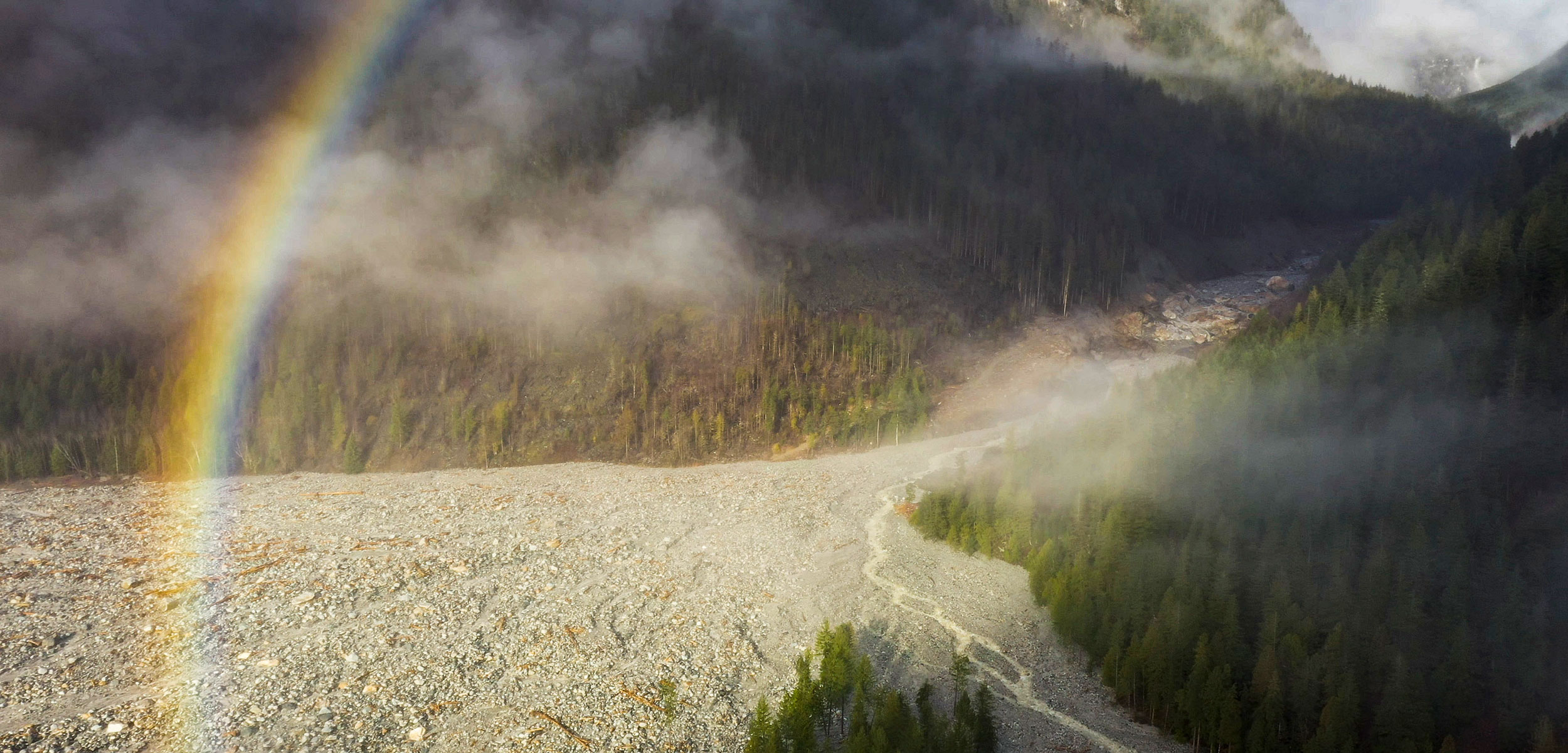Massive Landslide Cools Fjord
An extended marine heatwave left British Columbia’s fjords hotter than usual. A single landslide has brought one inlet back to its pre-heatwave temperature.
Article body copy
A massive landslide on the west coast of Canada has had unprecedented impacts on one of the country’s giant fjords. The slide has wiped out salmon habitat in Bute Inlet, British Columbia, but also cooled the inlet’s waters, reversing the recent and worrying warming caused by a potent marine heatwave.
The landslide is a lesson in the sometimes-surprising nature of climate change’s effects across various ecosystems, says oceanographer Jennifer Jackson of the Hakai Institute.* “There could be interesting feedbacks that we haven’t considered,” says Jackson, who has been monitoring Bute Inlet’s conditions in monthly expeditions. In this case, climate change melted a glacier, which encouraged a landslide, which pushed glacial lake water into an otherwise-warming fjord. In other words, climate change first caused the inlet to warm—and then cooled it.
The landslide happened in a remote area, about 200 kilometers northwest of Vancouver, British Columbia. Researchers think that melting permafrost and a retreating glacier destabilized the steep slope until it gave way on November 28, 2020. The slide pushed an estimated nine million cubic meters of debris into a lake made from the glacier’s meltwater, creating a wave that may have reached as high as 110 meters in spots. Water scoured out trees and rocks, while a mud slurry swept down the outlet creek and river, and a sediment-laden current traveled at least 70 kilometers down the inlet.
“It’s huge,” says geologist Brent Ward of British Columbia’s Simon Fraser University. “It’s going to be a case study for ages.”
The slide, Ward says, has revealed long-buried sediments that geologists didn’t have access to before, which might reveal interesting clues about other mysteries, such as ancient sea levels. “It’s hard to core in these regions; we couldn’t afford to bring in a drill. There’s no way,” he says.
The slide was in such a remote area that no one saw it happening, or even noticed it until days later. Jackson’s team headed into the inlet for a routine data collection trip on December 2, four days after the slide, and was turned back by rough conditions. “I remember our team coming back and saying they couldn’t complete the survey because the water was full of logs,” says Jackson. Within a couple of weeks, the researchers had pieced together enough clues to realize what had happened.
From the air, the devastation caused by roughly nine million cubic meters of falling debris is obvious. Video by the Hakai Institute
The physical force of the slide and wave was catastrophic, says Jackson. “There’s no way any salmon eggs in the system would have survived.” The sediment in Bute Inlet had all settled by December 14, she says, but the water is still different from how it was before.
Bute Inlet, along with some other fjords along British Columbia’s west coast, has been unusually warm in recent years. Jackson’s work suggests this is largely because of the so-called Blob, a large, deep marine heatwave that hit the coast from 2013 to 2016. The Blob’s warm waters sank and seeped into the fjords, creating an unusually warm, deep layer. Since 1951, deep water in Bute Inlet has warmed by about 1.3 ℃, she says—twice the global average.
Warm water can be bad news for salmon: heat can stress fish and change their food supply to less nutritious fare. The cold glacial water now mixed into the system has altered things significantly. According to Jackson’s data, around the year 2000, long before the Blob, the deep water in Bute Inlet was around 9.1 ℃. After the Blob, it hiked up to 9.6 ℃. The landslide brought it back down to 9.1 ℃.
“The landslide wiped out the heating we saw from the marine heatwave,” says Jackson.
The slide serves as a reminder of how things can change rapidly and in unexpected ways. There are many unknowns in this region, says Jackson: researchers don’t know why, for example, the water in Bute Inlet before the slide was already quite different from the water in nearby Toba Inlet, which has far less oxygen and is more acidic. Investigating the effects of the slide—on everything from temperature to sediment deposits and mineral levels in the water—might help to untangle some of those mysteries.
It’s unclear what the ultimate consequence of the landslide will be on salmon in the region, or whether the riverbed will be suitable for spawning for any fish returning to the inlet’s newly cooled waters next fall. The landslide may have caused “irreversible stress” for that region, Jackson says. But overall, she notes, Bute Inlet is just a small part of salmon habitat. “I don’t think it will affect them long-term,” she says.
* The Hakai Institute and Hakai Magazine are both part of the Tula Foundation. The magazine is editorially independent of the institute and foundation.

